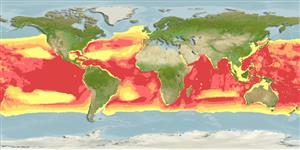Common names from other countries
Environment: milieu / climate zone / depth range / distribution range
экология
пелагический; мигрирует в океане (Ref. 75906); пределы глубины 0 - 3793 m (Ref. 94963), usually 500 - 1100 m (Ref. 80612). Tropical; 90°N - 90°S, 180°W - 180°E
Atlantic Ocean and Indo-Pacific.
Length at first maturity / Size / Вес / Возраст
Maturity: Lm ?, range 210 - 220 cm Max length : 270 cm TL самец/пол неопределен; (Ref. 1394); наибольший вес (опубликованные данные): 210.0 kg (Ref. 1394)
Robust. Short beak, subtriangular to weakly falcate dorsal fin, pointed flippers, and relatively small concave flukes. Dark bluish to brownish-gray dorsal cape, pale gray flank, and white to pinkish belly. Wide dark gray to black stripe extending from the eye to the anus, conspicuously set off by thin pale cream-colored borders.
Pantropical distribution. Dolphins are directly caught for use as shark-bait in Sta. Ana and Aparri, Philippines (Ref. 77119). Minimum depth from Ref. 116169. Often seen near shore, along the outer continental shelf and in deep oceanic waters (Ref. 80620). Feeds in deep waterse (Ref. 122680). Feeds on mid-water fish, squid and crustaceans (Ref. 1394). Forms large social groups (Ref. 122680). Occasionally sighted with melon-headed whales, Peponocephala electra. (Ref. 80612).
Does not show strong evidence of seasonality in calving (Ref. 80616).
Основная ссылка
ссылки | координатор | соавторы
Tan, J.M.L. 1995. (Ref. 936)
Статус Красного Списка МСОП (Ref. 130435)
Статус СИТЕС (Ref. 108899)
Использование человеком
рыболовство: коммерческий; наживка: usually
FAO - рыболовство: Видовой профиль | FishSource | Sea Around Us
инструменты
дополнительная информация
ресурсы в Интернет
Estimates based on models
Preferred temperature
(Ref.
115969): 1.5 - 3.8, mean 1.8 (based on 2563 cells).
устойчивость к внешним воздействиям
высокий, минимальное время удвоения популяции до 15 месяцев (K=0.48; tm=8).
Уязвимость
Moderate vulnerability (42 of 100).
Категория цены
Unknown.
